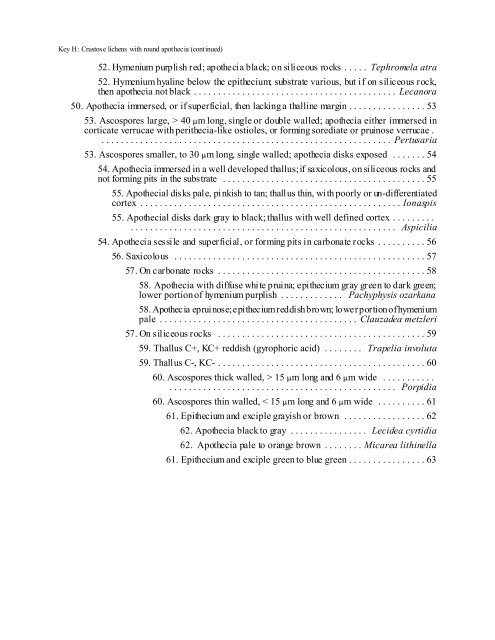lichens of the lower ozark region of missouri and arkansas
lichens of the lower ozark region of missouri and arkansas
lichens of the lower ozark region of missouri and arkansas
Create successful ePaper yourself
Turn your PDF publications into a flip-book with our unique Google optimized e-Paper software.
Key H : Crustose <strong>lichens</strong> with round apo<strong>the</strong>cia (continued)<br />
52. Hymenium purplish red; apo<strong>the</strong>cia black; on siliceous rocks ..... Tephromela atra<br />
52. Hymenium hyaline below <strong>the</strong> epi<strong>the</strong>cium; substrate various, but if on siliceous rock,<br />
<strong>the</strong>n apo<strong>the</strong>cia not black .......................................... Lecanora<br />
50. Apo<strong>the</strong>cia immersed, or if superficial, <strong>the</strong>n lacking a thalline margin ................53<br />
53. Ascospores large, > 40 �m long, single or double walled; apo<strong>the</strong>cia ei<strong>the</strong>r immersed in<br />
corticate verrucae with peri<strong>the</strong>cia-like ostioles, or forming sorediate or pruinose verrucae .<br />
............................................................ Pertusaria<br />
53. Ascospores smaller, to 30 �m long, single walled; apo<strong>the</strong>cia disks exposed .......54<br />
54. Apo<strong>the</strong>cia immersed in a well developed thallus; if saxicolous, on siliceous rocks <strong>and</strong><br />
not forming pits in <strong>the</strong> substrate ..........................................55<br />
55. Apo<strong>the</strong>cial disks pale, pinkish to tan; thallus thin, with poorly or un-differentiated<br />
cortex ......................................................Ionaspis<br />
55. Apo<strong>the</strong>cial disks dark gray to black; thallus with well defined cortex .........<br />
....................................................... Aspicilia<br />
54. Apo<strong>the</strong>cia sessile <strong>and</strong> superficial, or forming pits in carbonate rocks ..........56<br />
56. Saxicolous ....................................................57<br />
57. On carbonate rocks ...........................................58<br />
58. Apo<strong>the</strong>cia with diffuse white pruina; epi<strong>the</strong>cium gray green to dark green;<br />
<strong>lower</strong> portion <strong>of</strong> hymenium purplish ............. Pachyphysis <strong>ozark</strong>ana<br />
58. Apo<strong>the</strong>cia epruinose; epi<strong>the</strong>cium reddish brown; <strong>lower</strong> portion <strong>of</strong> hymenium<br />
pale ......................................... Clauzadea metzleri<br />
57. On siliceous rocks ...........................................59<br />
59. Thallus C+, KC+ reddish (gyrophoric acid) ........ Trapelia involuta<br />
59. Thallus C-, KC- ...........................................60<br />
60. Ascospores thick walled, > 15 �m long <strong>and</strong> 6 �m wide ...........<br />
............................................... Porpidia<br />
60. Ascospores thin walled, < 15 �m long <strong>and</strong> 6 �m wide ..........61<br />
61. Epi<strong>the</strong>cium <strong>and</strong> exciple grayish or brown .................62<br />
62. Apo<strong>the</strong>cia black to gray ................ Lecidea cyrtidia<br />
62. Apo<strong>the</strong>cia pale to orange brown ........Micarea lithinella<br />
61. Epi<strong>the</strong>cium <strong>and</strong> exciple green to blue green ................63


